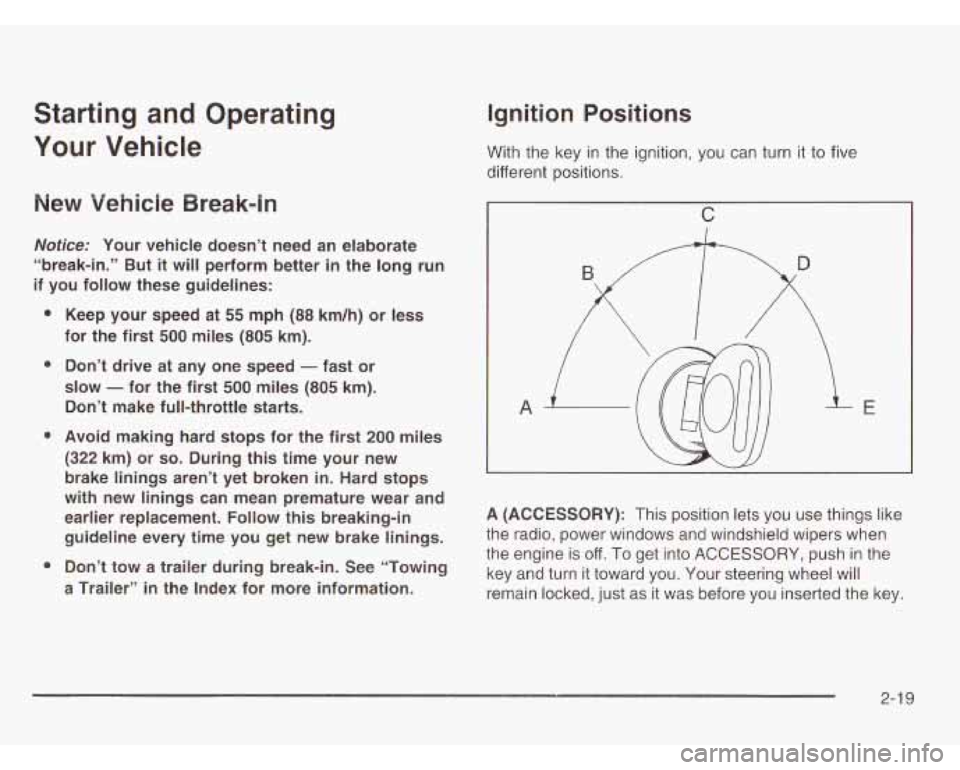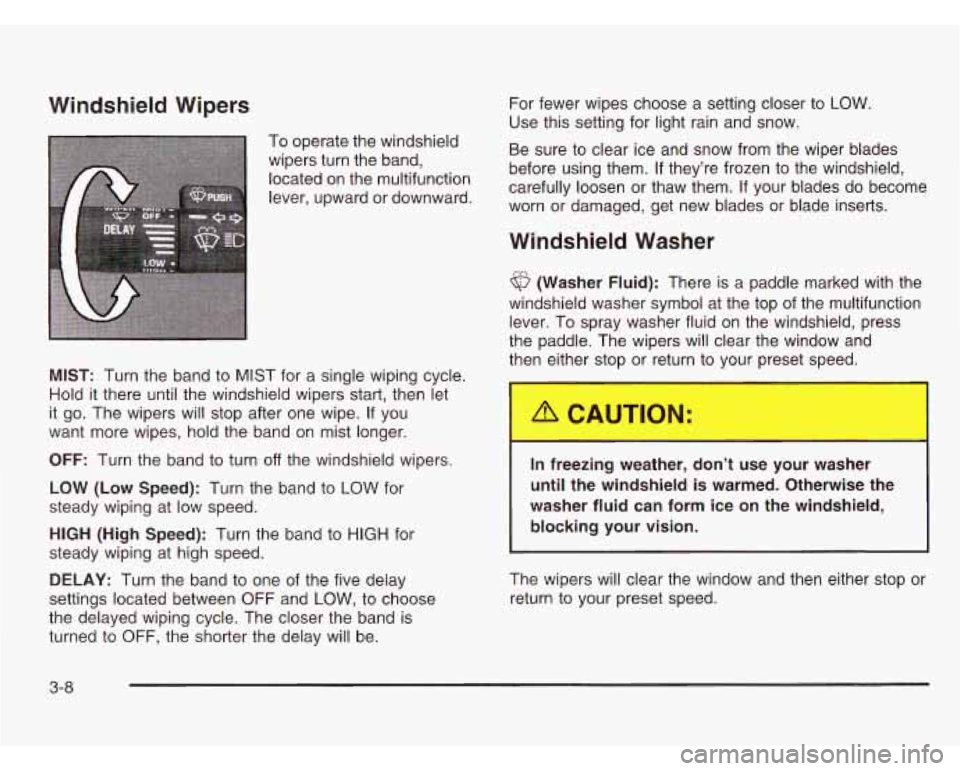2003 CHEVROLET ASTRO windshield wipers
[x] Cancel search: windshield wipersPage 98 of 386

Starting and Operating
Your Vehicle
New Vehicle Break-in
Nofice: Your vehicle doesn’t need an elaborate
“break-in.” But
it will perform better in the long run
if you follow these guidelines:
e
e
Keep your speed at 55 mph (88 km/h) or less
for
the first 500 miles (805 km).
Don’t drive at any one speed
- fast or
slow
- for the first 500 miles (805 km).
Don’t make full-throttle starts.
Avoid making hard stops for the first
200 miles
(322 km) or so. During this time your new
brake linings aren’t yet broken in. Hard stops
with new linings can mean premature wear and
earlier replacement. Follow this breaking-in guideline every time you get new brake linings.
Don’t tow a trailer during break-in. See “Towing
a Trailer” in the Index for more information.
Ignition Positions
With the key in the ignition, you can turn it to five
different positions.
C
A
A (ACCESSORY): This position lets you use things like
the radio, power windows and windshield wipers when
the engine is off.
To get into ACCESSORY, push in the
key and turn it toward you. Your steering wheel will
remain locked, just as it was before you inserted the key.
2-1 9
Page 131 of 386

Turn SignaVMultifunction Lever
The lever on the driver’s side of the steering column
includes the following:
Turn and Lane Change Signals
Headlamp High/Low-Beam Changer
Flash-to-Pass
Windshield Wipers
Windshield Washer
Cruise Control (Option)
Turn and Lane Change Signals
The turn signal has two upward (for right) and two
downward (for left) positions. These positions allow you
to signal a turn or a lane change.
To signal a turn, move the lever all the way up or
down. When the turn is finished, the lever will return
automatically.
An arrow on the instrument
Dane1 cluster will flash in
the direction of the
turn or lane change.
To signal a lane change, just raise or lower the lever
until the arrow starts to flash. Hold it there until you
complete your lane change. The lever will return by itself
when you release it.
As you signal a turn or a lane change, if the arrows
flash faster, a signal bulb may be burned out and other
drivers won’t see your turn signal.
For information on the exterior lamps, see
Exterior
Lamps
on page 3-12.
3-6
Page 133 of 386

Windshield Wipers For fewer wipes choose a setting closer to LOW.
Use this setting for light rain and snow.
- -
To operate the windshield
wipers turn the band,
located On the multifunction carefully loosen or thaw them. If your blades do become
lever’ Or worn or damaged, get new blades or blade inserts. Be
sure to clear ice and snow from the wiper blades
before using them.
If they’re frozen to the windshield,
Windshield Washer
6 (Washer Fluid): There is a paddle marked with the
windshield washer symbol at the top of the multifunction
lever. To spray washer fluid on the windshield, press
the paddle. The wipers will clear the window and
then either stop or return to vour preset speed.
MIST: Turn the band to MIST for a single wiping cycle.
Hold
it there until the windshield wipers start, then let
it go. The wipers will stop after one wipe. If you
want more wipes, hold the band on mist longer.
OFF: Turn the band to turn off the windshield wipers.
LOW (Low Speed): Turn the band to LOW for
steady wiping at low speed.
HIGH (High Speed): Turn the band to HIGH for
steady wiping at high speed.
DELAY: Turn the band to one of the five delay
settings located between OFF and
LOW, to choose
the delayed wiping cycle. The closer the band is
turned to OFF, the shorter the delay will be.
In freezing weather, don’t u- - your washer
until the windshield is warmed. Otherwise the
washer fluid can form ice on the windshield,
blocking your vision.
The wipers will clear the window and then either stop or
return to your preset speed.
3-8
Page 309 of 386

Electrical System
Add-on Electrical Equipment
Notice: Don’t add anything electrical to your vehicle
unless you check with your dealer first. Some
electrical equipment can damage your vehicle and
the damage wouldn’t be covered by your warranty.
Some add-on electrical equipment can keep other
components from working
as they should.
Your vehicle has an air bag system. Before attempting to
add anything electrical to your vehicle, see
Servicing
Your Air Bag-Equipped Vehicle on page
1-69.
Headlamp Wiring
The headlamp wiring is protected by a circuit breaker in
the lamp switch. An electrical overload will cause the
lamps to flicker on and
off, or in some cases to remain
off. If this happens, have your headlamp wiring
checked right away.
Windshield Wiper Fuses
The windshield wiper motor is protected by a circuit
breaker and a fuse.
If the motor overheats due to heavy
snow, etc., the wiper will stop until the motor cools.
Although the circuit is protected from electrical overload,
overload due to heavy snow, etc., may cause wiper
linkage damage. Always clear ice and heavy snow
from the windshield before using the windshield wipers.
If the overload
is caused by some electrical problem
and not snow, etc., be sure to get it fixed.
Power Windows and Other
Power Options
Circuit breakers in the fuse panel protect the power
windows and other power accessories. When the
current load is too heavy, the circuit breaker opens and
closes, protecting the circuit until the problem is fixed
or goes away.
5-92
Page 381 of 386

Vehicle Identification
Number (VIN)
............................................. 5-91
Vehicle Storage
.............................................. 5-47
Vinyl
............................................................. 5-85
Visor Vanity Mirror
.......................................... 2-17
Visors
........................................................... 2-1 7
Voltmeter Gage
.............................................. 3-28
Service Parts identification Label
................... 5-91
When
to Add Engine Oil
.................................. 5-16
When to Change Engine Oil
............................. 5-18
When to Check
.............................................. 5-64
When to Check and Change
............................ 5-25
When
to Check Lubricant ................................. 5-53
When to Check Power Steering Fluid
................ 5-40
When You Are Ready to Leave After
Parking on a Hill
......................................... 4-40
Where to Put the Restraint
............................... 1-47
Why Safety Belts Work
.................................... 1-14
Windows
....................................................... 2-16
Manual
...................................................... 2-16
Power
........................................................ 2-17
Windshield and Wiper Blades
........................... 5-87
Windshield Washer
........................................... 3-8
Fluid
.......................................................... 5-41
Windshield Washer Fluid Level Check
................ 6-26
Windshield Wiper
Blade Replacement
...................................... 5-62
Fuses
........................................................ 5-92
Windshield Wipers
............................................ 3-8
Winter Driving
............................................ 4-24
Wiper Blade Check
.... ............................. 6-27
Warning Lights. Gages and
Indicators
................ 3-23
Warnings Hazard Warning Flashers
............................... 3-4
Other Warning Devices
.................................. 3-5
Safety and Symbols
......................................... 111
Vehicle Damage .............................................. iv
Washing Your Vehicle
.................. ............ 5-86
Weatherstrip Lubrication
................... ........ 6-27
Weight of the Trailer Tongue
............................. 4-35
What Kind of Engine Oil to Use
........................ 5-17
What to Do with Used Oil
................................ 5-19
What to Use
.......................... 5-28, 5-40, 5-41, 5-53
Wheels Alignment and Tire Balance 5-69
...
Weight of the Trailer ........................................ 4-33
Y ..........................
Replacement .................... .... ......... 5-69 four Vehicle and the Environment ....... .. 6-2
14